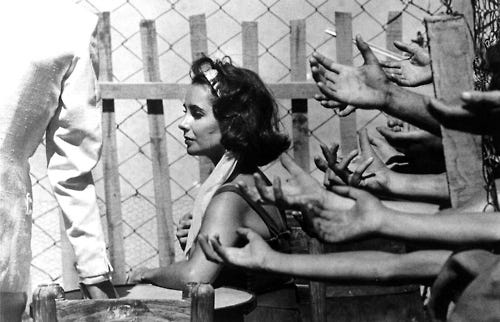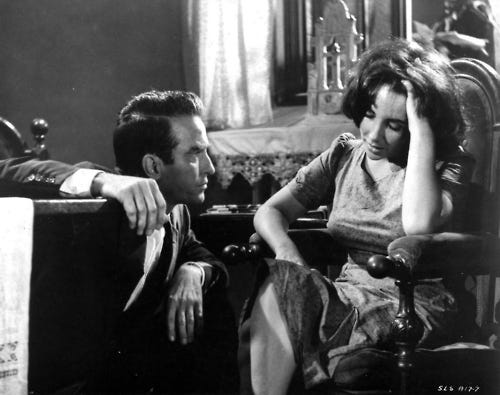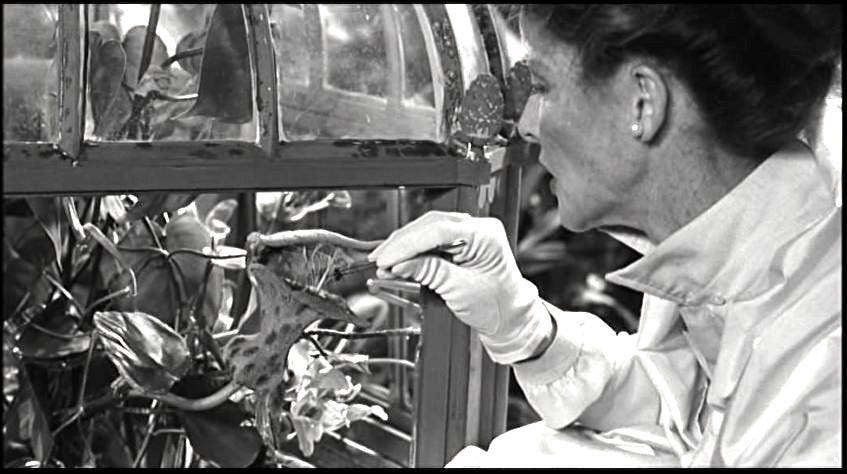Tennessee Williams In Conversation
New Orleans
1982
Both as a play--Garden District--and as the film that is Suddenly, Last Summer, I conceived a series of confessions, revelations, dark secrets suddenly revealed. The film is an autumn shadow box--Joseph Cornell armed with formaldehyde--and the sun, which is to say the truth, suddenly beams through, cleansing, revealing, destroying. Truth is not always a welcome or healing thing: It destroys every bit as much as it remedies.
Secrets and shadow boxes can be very comforting--the comfort of acquisition: of people, things, ideas, power. Mrs. Venable, the Catholic Church, the medical establishment: all possess power and wealth and the means to assert both. These three entities--a most unholy trinity--present as healers, helpers, but they truly want to kill, cauterize, control.
Gore Vidal understood all of this--perhaps more than I ever could, and he acquitted himself beautifully with the screenplay. I can realize this now. I did not fully appreciate the use of Joseph Mankiewicz as the film's director: His body of work did not seem to have prepared him for this film, but he surrendered, as well he should have, to the brilliance of Oliver Messel, who designed the film meticulously, and with a particular emphasis on the mental and religious metaphors I had applied to the text.
The cinematographer--Jack Hildyard--was slavish in his attentions to Oliver, and his use of light--and the lack of it--are extraordinary. It took me a good decade to wait and remove myself from the person I was during the filming to watch it again and to recognize that the film honored me to a great degree.
I had given Gore a note that the film and its principals were all possessed of an aesthetic appeal and the burnish of wealth, but that their corners were all crowded with secrets, skeletons, sins. Very much like the most glorious of cathedrals and churches--in New Orleans, New York, Rome, France, tiny hamlets across the world. Great beauty with death and decay in the corners and acting as a sort of wax on the floors and the pews and the glass ornaments. In our living we are dying, and in our telling we are lying. We cannot face ourselves, so we create an ideal man in the image of whatever God we pick from the buffet of belief. But the real man--old sin nature, I think we hear it called in the book of Romans--keeps coming forward: A secret that cannot lie dormant; dust that rolls across the floor of the most glorious cathedral.
No light can penetrate a lie, and light would kill the pretenses set up to shield and enhance a lie. The Venable home--its gardens and its antiques and its adherence to polite activities and good silver and appearances--can never be pierced by light: It would reveal too much and damage the linens and the flowers. A lie--a series of lies--require a curatorial touch, a cultivation that is beyond most of us. Oliver understood that a richness of detail would be necessary, as would an inability for light or clarity to take hold for very long. The film is a deliberate, shadowy blur. A dream, but a dream made bleary by lies, misdirection.
Elizabeth's character must always be trapped--by belief, by people, by custom, by furniture, by impossible means of ascent to truth or to escape, and all of this was achieved beautifully.
Everyone is trapped--flesh on one side; faith on another. Where is one's faith? Money? Youth? Sex? Some characters are pursued for their beauty, and they find they are imprisoned both by their needs and those of the many who need their gifts.
Mrs. Venable descends in her machine--she is very much God: in her city, in her self-created drama, in the lives of her son and his hapless survivor. Her descent--toward truth and light--is the most dramatic, and we must wonder what she endures when the film is over, when the curtain falls. She is left with truth and the memory of her devoured son. Her dreams and her delusions were devoured with the son, and she is truly empty, cored to the bone.
Both Elizabeth Taylor and Katharine Hepburn worked at the top of their forms, and both were beautiful. Hepburn allowed herself to be revealed in all of her mottled majesty in the final scene, when not a single filter was used to display her ruined silhouette, but Elizabeth was allowed to ripen and to be revealed in all of her abundant beauty. Both were ambulatory art objects.
There are so many differences between Taylor and Hepburn, but Oliver realized that one of the primary ones had to do with color: Hepburn came to stardom and thrived in the hot silvers of black and white film. Black and white photography, pocked with tricks and lighting aids, rendered her creamy and highlighted her wonderful bones. Color diminished her somehow. Elizabeth was and is beautiful in any color, any medium, but color amplifies her supernal beauty: It literally reaches out and subsumes the viewer. We took photographs of Elizabeth in color and realized the film could never work unless we subdued her and took away the pigments that made her magical. Color completed her.
Elizabeth was a rainbow of colors and lights and Kate worked best in shadows and angles.










